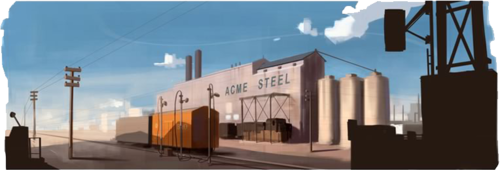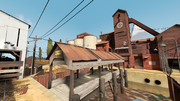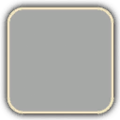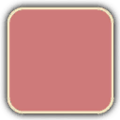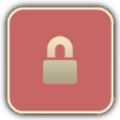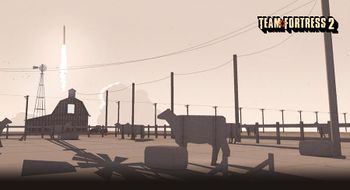List of game modes/zh-hant
目前絕地要塞2擁有 7 種遊戲模式。雖然遊戲剛開始時只有三種,但隨著眾多的更新增加了新模式,像是彈頭車(Payload)、競技場(Arena)和山丘之王(KOTH)。 現在總共有 39 張官方地圖。
內容
搶奪情報箱(CTF)
| “ | 揮手告別後說沒用的悄悄話,蠢透了!Wave goodbye to ya secret crap, dumbass!
點擊試聽
— The Scout
|
” |
'搶奪情報箱模式的特色就是藍隊與紅隊之間都有各自的情報箱(作為被搶奪的旗幟)。雙方的目標都是不斷地搶奪對方的情報箱直至搶奪次數達到3次為止(預設數值為3)並同時阻止與自己有著同樣目標的敵隊。
雙方團隊的情報箱通常都會安置於雙方各自的據點深處的「情報間」,並且通常都與對方互相對稱。玩家必須操控角色去碰觸對方情報以拾取對方情報箱,當攜帶著敵方情報時,玩家必須將其攜帶入已方的「奪取區域」(由黃線與黑線示明)從而成功奪得對方情報。當成功奪得對方情報箱之後,成功奪得情報箱的全隊玩家都將會獲得數秒的暴擊時間作為獎勵。
若攜帶情報箱的玩家被殺死或是進入禁區(例如重生區域)而導致情報箱掉落,情報箱將會滯留原地60秒種,若這段時間內沒有其他已放玩家來將此情報箱奪走,此情報箱將會被自動歸還至對方「情報間」。而每次一旦這個情報箱被已方玩家再次拾起,無論持有多久,再次掉落後仍可以獲得60秒的滯留時間。在掉落期間,原本保護此情報箱的團隊是無法通過任何行為將此情報箱歸位的。無敵狀態的玩家也無法拾起情報箱(例如:ÜberCharge狀態之下的玩家與使用了BONK! 原子能量飲料的Scout),而間諜在攜帶情報箱的狀態時也無法進行偽裝或隱形。
若攜帶情報箱的玩家在地圖不可及的部分死亡而掉落(例如:死亡跌落區域),情報箱將會立刻歸位至「情報間」中。若沒有任何一方在回合結束前成功奪取過一次情報箱,遊戲將進入驟死戰模式。
不同於其他遊戲中奪旗模式的變種,你可以不去搶奪情報箱也能得分。
控制點(CP)
| “ | This point ain't gonna cap itself! Get over here!
點擊試聽
— The Engineer
|
” |
參見: 控制點
控制點模式主要分為兩類主要的分支模式。
Control points are circular platforms with a team-colored light in the center (neutral points will have a white light). To capture a point owned by the enemy team, the player simply stands on the point until the capture meter fills with your team color. The more people of the same team on a point, the faster it will capture, though only to a limited extent. Scouts and those wielding a Pain Train count as 2 players when capturing points. No capture progress will be made when players of both teams are on the point. If all the capturing players are killed or driven off before the capture is completed, the capture progress will not reset immediately but instead will slowly fade away.
There are three statuses for a Capture Point:
控制點地圖主要有兩類主要分支:標準 5 控制點占領模式以及攻擊/防禦控制點模式(A/D)
標準 5 控制點佔領模式
Standard control point (or Linear Control Point) maps play symmetrically. Both teams start with an equal number of two controlled points and a central point starts out controlled by neither team. The team that captures all the points wins. Traditional Control Point maps will go into Sudden death (or Stalemate) if no team captures all the points before times runs out. Control points close to a team's spawn point are captured more quickly by the enemy team.
Standard control point maps:
攻擊/防禦控制點模式(A/D)
Attack/Defend maps play asymmetrically. [[[RED]] begins with all the points in their control. BLU wins if it captures all of RED's points. Points may only be captured in a set order (though some maps, such as Gravel Pit and Steel, may make exceptions). RED wins if it prevents BLU from capturing all points before the timer expires. Points captured by BLU are typically locked and cannot be taken back.
Attack/Defend maps can come in various styles. Some maps such as Dustbowl, and Egypt require BLU, the attacking team, to go through multiple stages before they can ultimately win the map. If the attacking team fails to win each stage, teams will switch and the defenders will then take turn to be the attackers. Other maps such as Gravel Pit and Junction, allow the attacker to capture two points in no particular order (points A or B) before attacking the final point (point C). Steel is a unique Attack/Defend map in that capturing each minor capture point (points A,B,C and D) will allow better accessibility to the main point (point E), such as allowing more routes into point E or extending bridges to the point so that classes other than the Scout, Soldier or Demoman can capture it.
Attack/Defend maps:
地區控制模式(TC)
In Territorial control the goal is to take over the entire map by capturing 'territories'. Each game is randomly selected from the six available layouts in a 'point against point' game where both teams must capture the opposite point while preventing their own. After a team successfully captures their opposite point, the next round takes place in a different area of the map which is also randomly generated. After a team captures all four territories, the offending team must now capture the enemy team's base while the other defends it. If the base point is captured the team wins the round, the offending team loses their closest point to the base (in Hydro, the Radar Dish for RED, The Power plant for BLU). When the next round begins, territories are reset and a new random game is selected.
In any game in TC (except in RED/BLU base games), if a point is not captured within the eight minute time clock, the game then will go into Sudden Death mode.
Territorial control maps:
彈頭車(Payload)
| “ | Onward, great bomb-cart!
— The Heavy
|
” |
In Payload maps, BLU team must escort a cart full of explosives through a series of checkpoints and into RED's base within a certain amount of time. BLU team members move or 'push' the cart by standing next to it - the more people nearby the cart, the faster it moves. Any RED team member standing near the cart will stop it from venturing further. If no BLU player pushes the cart after 30 seconds have passed, the cart will start moving backwards slowly until it reaches a checkpoint/BLU spawn or a BLU player stands next to it again. The cart works as a level 1 Dispenser for BLU team (and disguised enemy Spies) to restore health and ammunition to those pushing it.
Payload maps may or may not be split into multiple rounds. Some maps traditionally have one-way routes from the BLU side, sometimes closed off until a specific point is taken.
Some maps such as Gold Rush, Hoodoo and Thunder Mountain are split in three stages that BLU must advance through and win. Stages one and two have 2 checkpoints and stage three has 3 checkpoints (2 for Hoodoo) , counting the final point as such. Badwater Basin and Upward maps have a single round with 4 checkpoints, counting the final point as such. Advancing the cart to the next checkpoint gives the BLU team extra time. Advancing it to the final point moves the map onto the next stage. When the cart reaches the final point on the final stage, the Payload explodes and destroys RED base, symbolizing BLU's victory.
Payload maps:
彈頭車競賽(Payload Race)
Unlike standard Payload maps, Payload race maps feature both RED and BLU issued with a cart, thus teams are not defined to a attacking or defending role. To win, each team must simultaneously push their cart through enemy territory to reach the finishing point while preventing the enemy team from doing the same. As with Payload mode, team members push the cart by standing next to it, with more members increasing the speed of the cart and any opposing team member standing near the cart will stop it.
Unlike Payload mode, the cart will not move backwards after any duration of time and there is no time limit; the map will only end when one team successfully pushes their cart to the finish point. Each cart works as a Dispenser for their team (and disguised enemy Spies), restoring health and ammunition to those pushing the cart. Parts of the track may feature slopes, on which the cart will quickly roll back down to the bottom unless it is being constantly pushed.
Payload race maps may or may not be split into multiple rounds.
Payload race maps:
競技場(Arena)
| “ | I say this to you with the unvarnished factualism of plain talk: I love Arena Mode.
— - Abraham Lincoln, Second Inaugural Address, 1865
|
” |
Arena maps are designed to keep the class diversity of Team Fortress 2 while focusing goals around combat between two teams. Whereas other game modes lean towards a broad, overall strategy for the team, Arena concentrates on the specific tactical choices the teams make in a single fight. Arena maps carry the arena_prefix.
Arena features smaller maps that play out for shorter periods of time. The round ends once one team has no players left in the arena, or when the central capture point has unlocked and been captured. The central capture point unlocks after one minute has passed in the current round. Rounds tend to be very fast and highly competitive, with an emphasis on your team's class makeup and your plan to counter the opposing team's class choices. Arena mode is suitable for smaller matches of three vs. three players, while still comfortably supporting huge knockdown twelve-on-twelve brawls. Arena works much like Sudden Death - respawning is disabled and there are no resupply lockers. There are usually very few health kits available, often located far from the main action and/or near high-risk hazards. This forces teams to rely more on Dispensers and Medics.
Players may have to sit out to balance keep team numbers equal if they were on the losing team, but players on the winning team never have to sit out the next round.
The First blood critical buff is unique to the Arena game mode.
Arena maps:
山丘之王(KOTH)
| “ | Since their discovery in 1895, hills have fascinated kings.
— The Classless Update
|
” |
King of the Hill is similar to Arena. King of the Hill focuses on a single control point at the center of the map, which is unowned and locked at the beginning of the round. Teams must make their way to the Control Point and capture it when it becomes available. Once the point is captured by a team, their team clock will start a three minute countdown. If the enemy team manages to capture the point back, their clock will start counting down while the other team’s clock freezes at the time the point was recaptured. A team wins once they own the point and their three minutes is expired.
King of the Hill maps:
訓練模式(Training Mode)
Training maps are made specifically for teaching people the basics of gameplay and advanced techniques. Training mode shipped with the Mac Update, which introduced two official training maps.
其他模式
"只限一人"模式(Highlander)
| “ | There can be only one!
點擊試聽
— The Demoman
|
” |
Applicable to all existing game modes, Highlander mode restricts the number of players of each team to 9 players, and only allows one player per class on each team. It is applicable to any game mode, and can be activated by entering mp_highlander 1 into the console.
The idea behind Highlander mode existed previous to its official inclusion in the game, and has been implemented in server mods. Highlander mode was officially added in the February 3, 2010 Patch.
